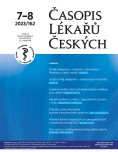Trends in fertility and abortion in Czechia
Authors:
Jiřina Kocourková 1; Anna Šťastná 1, 2; Bára Idlbeková 1; Jitka Slabá 1
Published in:
Čas. Lék. čes. 2023; 162: 299-306
Category:
Review Article
Overview
The assessment of the development of fertility and abortion rates over the last three decades shows that Czechia has reached the top position in Europe with a total fertility rate of 1.83 children per woman in 2021. The postponement of fertility to women’s older age, which was behind the sharp drop in fertility to 1.1, has been gradually slowed down and halted between 2015 and 2021. In recent years, there has been an increase in fertility rates for women aged 30 and older as well as a balanced increase for women under 30. In the European context Czechia has maintained its position as a country with lower rates of reproductive ageing. The favourable demographic position of Czechia among European countries is also illustrated by the relatively low level of the abortion rate. The postponement of female fertility to older ages has not been accompanied by an increase in the abortion rate among young women, but on the contrary a decline in fertility has been accompanied by a decline in the abortion rate.
Given the year-on-year increase in total fertility (from 1.71 in 2020 to 1.83 in 2021), the initial effect of the COVID-19 pandemic on fertility can be assessed positively. However, the subsequent decline to 1.62 in 2022 is already the result of a combination of adverse effects stemming from the consequences of antipandemic measures and worsening economic conditions, to which new security risks associated with the war in Ukraine have subsequently been added. This has created the conditions for a further postponement of fertility until women are older.
Keywords:
fertility, abortion, reproductive ageing, fertility postponement
Sources
- Kocourková J. Plánované rodičovství a reprodukční ztráty. In: Burcin B a kol. Demografická situace České republiky: Proměny a kontexty. SLON, Praha, 2010 : 157–168.
- Kocourková J, Slabá J, Šťastná A. The role of cohorts in the understanding of the changes in fertility in Czechia since 1990. AUC Geographica 2022; 57 (1): 61–74.
- Polesná H, Kocourková J. Je druhý demografický přechod stále relevantní koncept pro evropské státy? Geografie 2016; 121 (3): 390–418.
- Kocourková J. Reprodukční stárnutí v české populace. Gynekologie a porodnictví 2018; 2 (1): 3–6.
- Obyvatelstvo – roční časové řady. Pohyb obyvatel České republiky v letech 1920–2022: analytické ukazatele. ČSÚ. Dostupné na: www.czso.cz/csu/czso/obyvatelstvo_hu
- Human Fertility Database. Max Planck Institute for Demographic Research (Germany) and Vienna Institute of Demography (Austria). Dostupné na: www.humanfertility.org
- Rossier C, Toulemon L, Prioux F. Abortion trends in France. Population-E 2009; 64 : 443–476.
- Sydsjö A, Josefsson A, Sydsjö G. Trends in induced abortions between 1975 and 2000 in a cohort of women born in 1960–64 in four Scandinavian countries. Eur J Contracept Reprod Health Care 2009; 14 : 334–339.
- European Demographic Datasheet 2022. Wittgenstein Centre (IIASA, VID/OEAW, University of Vienna), Vienna. Dostupné na: www.populationeurope.org
- Sobotka T, Zeman K, Lesthaeghe R et al. Postponement and recuperation in cohort fertility: Austria, Germany, and Switzerland in a European Context. Comparative Population Studies 2011; 36 (23): 417–452.
- Kocourková J, Šťastná A. The realization of fertility intentions in the context of childbearing postponement: comparison of transitional and post-transitional populations. J Biosoc Sci 2021; 53(1): 82–97.
- Šťastná A, Kocourková J, Šídlo L. Reprodukční stárnutí v Česku v kontextu Evropy. Časopis lékařů českých 2019; 158 : 126–132.
- Database: Population and Social Conditions – Fertility Indicators. Eurostat. Dostupné na: https://ec.europa.eu/eurostat/databrowser/view/demo_find/default/table?lang=en
- Slabá J. Vládní boj proti pandemii: přehled opatření vydaných v souvislosti s pandemií onemocnění COVID-19 v Česku v letech 2020 a 2021. Demografie 2022; 64 (2): 175–196.
- Pohyb obyvatelstva – rok 2022. ČSÚ. Dostupné na: www.czso.cz/csu/czso/cri/pohyb-obyvatelstva-rok-2022
- Ročník narozených 2022 je nejslabší za posledních 18 let. ČSÚ. Dostupné na: www.czso.cz/csu/czso/rocnik-narozenych-2022-je-nejslabsi-za-poslednich-18-let
- Bujard M, Andersson G. Fertility declines near the end of the COVID-19 pandemic: Evidence of the 2022 birth declines in Germany and Sweden. BiB Working Paper 2022; 6.
- Sobotka T, Jasilioniene A, Zeman K et al. From bust to boom? Birth and fertility responses to the COVID-19 pandemic. Dostupné na: https://osf.io/preprints/socarxiv/87acb
Labels
Addictology Allergology and clinical immunology Angiology Audiology Clinical biochemistry Dermatology & STDs Paediatric gastroenterology Paediatric surgery Paediatric cardiology Paediatric neurology Paediatric ENT Paediatric psychiatry Paediatric rheumatology Diabetology Pharmacy Vascular surgery Pain management Dental HygienistArticle was published in
Journal of Czech Physicians

Most read in this issue
- Artificial intelligence in medicine and healthcare: Opportunity and/or threat
- Trends in fertility and abortion in Czechia
- Zogala D. Artificial intelligence in medical imaging
- Questions and questionnaires about acute climacteric syndrome
